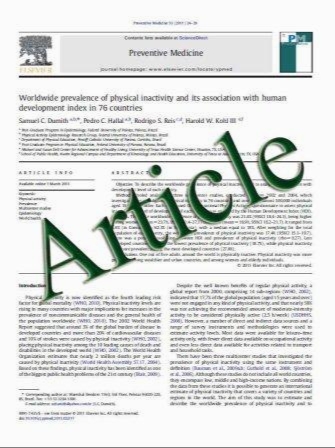Insulin resistance is associated with at least threefold increased risk for prothrombotic state in severely obese youngsters
- نوع فایل : کتاب
- زبان : انگلیسی
- مؤلف : Assimina Galli-Tsinopoulou & Ioannis Kyrgios & Ioanna Maggana & Eleni Z. Giannopoulou & Eleni P. Kotanidou & Charilaos Stylianou & Emmanouil Papadak
- چاپ و سال / کشور: 2011
Description
Obesity in childhood increases the risk for early adult cardiovascular disease. However, the underlying mechanism is not fully known. The aims of this study were to measure levels of prothrombotic factors and examine their possible association with obesity and insulin resistance in obese children and adolescents. A total of 313 obese children and adolescents were recruited. In a cross-sectional design, we measured anthropometric parameters, plasminogen activator inhibitor-1-antigen (PAI-1-Ag), von Willebrand factorantigen (vWF-Ag), fibrinogen (FB), lipids, fasting glucose, and insulin (FI) levels. Insulin resistance was estimated using the homeostasis model assessment for insulin resistance (HOMA-IR) index. Boys presented significantly higher PAI- 1-Ag levels than girls (82.6 vs. 71.3 ng/ml, p=0.01). Higher levels of PAI-1-Ag (96.8 vs. 69 ng/ml, p<0.001), vWF-Ag (123.5 vs. 107.6%, p=0.004) but not FB (353.1 vs. 337.6 mg/dl, p=0.137) were found in insulin-resistant (IR) participants after adjusted for age, gender, and pubertal stage. IR patients were at 2.98 (CI: 1.084.8.193) and 4.86 (CI: 1.119.15.606) times greater risk for high PAI-1-Ag and vWF-Ag levels, respectively. All three prothrombotic factors were positively correlated with body mass index (BMI) and FI levels (p<0.05), but only PAI-1-Ag and vWFAg were significantly correlated with HOMA-IR index (p.0.001). After adjustment for confounding factors, both BMI and HOMA-IR indices remained significantly associated with PAI-1-Ag (r2=0.225, p<0.001) and vWFAg levels (r2=0.077, p=0.003). Conclusion: This study shows that obesity in youngsters, when accompanied with insulin resistance, is associated with at least threefold increased risk for elevated levels of prothrombotic factors, contributing to the early development of atherothrombosis. This impaired prothrombotic state may partially explain the increased risk for developing cardiovascular disease later in adulthood.
Eur J Pediatr (2011) 170:879–886 DOI 10.1007/s00431-010-1370-9 Received: 4 July 2010 / Accepted: 24 November 2010 / Published online: 8 December 2010


